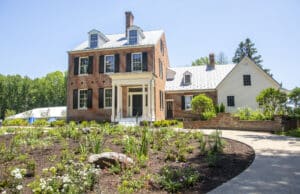
Woodlawn History Center, a house originally built in 1735, at the Smithsonian Environmental Research Center. (Credit: Michael Barnes/Smithsonian)
The landscape of southern Maryland bears little resemblance to what it was 300, 200 and even 100 years ago. Archaeology has uncovered the movement of soils and the creation of new hills and basins. Join Jim Gibb, head of the Smithsonian Environmental Archaeology Lab, for a journey across an ever-changing terrain. Starting at SERC’s historic 1735 Woodlawn House, he will narrate how a port town was buried in sediment, how garbage from Baltimore and Washington became a crucial resource for farmers, and how Eastern Europeans gradually came to reside on once-abandoned Maryland farms.
This event is part of the Smithsonian Environmental Research Center’s free Earth Optimism series. The webinar will be recorded! Closed captioning will be available on both the live event and on the recording. By signing up on Zoom, you’ll be able to join live and receive a link to the recording approximately one week after it airs.
